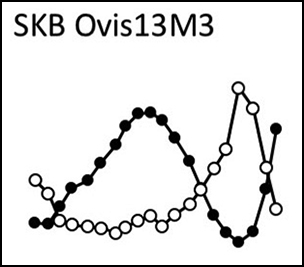Crossref Citations
This article has been cited by the following publications. This list is generated based on data provided by
Crossref.
Navarrete, Vanessa
Tornero, Carlos
Balasse, Marie
and
Saña, Maria
2019.
Food management of early introduced caprine and bovine herds in the early Neolithic site of La Draga (Banyoles): An isotopic approach.
International Journal of Osteoarchaeology,
Vol. 29,
Issue. 6,
p.
986.
Kamjan, Safoora
Gillis, Rosalind E.
Çakırlar, Canan
Raemaekers, Daan C. M.
and
Biehl, Peter F.
2020.
Specialized cattle farming in the Neolithic Rhine-Meuse Delta: Results from zooarchaeological and stable isotope (δ18O, δ13C, δ15N) analyses.
PLOS ONE,
Vol. 15,
Issue. 10,
p.
e0240464.
Blanz, Magdalena
Mainland, Ingrid
Richards, Michael
Balasse, Marie
Ascough, Philippa
Wolfhagen, Jesse
Taggart, Mark A.
and
Feldmann, Jörg
2020.
Identifying seaweed consumption by sheep using isotope analysis of their bones and teeth: Modern reference δ13C and δ15N values and their archaeological implications.
Journal of Archaeological Science,
Vol. 118,
Issue. ,
p.
105140.
Vila, Emmanuelle
Abrahami, Philippe
Albesso, Moussab
Amane, Agraw
Bader, Camille
Berthon, Rémi
Bouzid, Sofiane
Bradley, Daniel
Breniquet, Catherine
Chahoud, Jwana
Cucchi, Thomas
Davoudi, Hossein
de Cupere, Bea
Escarguel, Gilles
Estrada, Oscar
Gourichon, Lionel
Helmer, Daniel
Huangfu, Wei
Lesur, Joséphine
Mashkour, Marjan
Michel, Cécile
Mohaseb, Azadeh
Orlando, Ludovic
Pompanon, François
Studer, Jacqueline
and
Vuillien, Manon
2021.
EVOSHEEP: the makeup of sheep breeds in the ancient Near East.
Antiquity,
Vol. 95,
Issue. 379,
Sierra, Alejandro
Merino, Guillem Oriol
Rivals, Florent
and
Saña, María
2021.
Feeding practices and management of domestic mammals during the Neolithic in the Iberian Peninsula through dental microwear.
Historical Biology,
Vol. 33,
Issue. 12,
p.
3241.
Bunting, M. Jane
Farrell, Michelle
Dunbar, Elaine
Reimer, Paula
Bayliss, Alex
Marshall, Peter
and
Whittle, Alasdair
2022.
Landscapes for Neolithic People in Mainland, Orkney.
Journal of World Prehistory,
Vol. 35,
Issue. 1,
p.
87.
Blanz, Magdalena
Stewart, Samuel
Mainland, Ingrid
Ascough, Philippa
Raab, Andrea
Feldmann, Jörg
and
Taggart, Mark A.
2022.
Trace element ratios in tooth enamel as palaeodietary indicators of seaweed consumption and coastal grazing, and their broader applicability.
Journal of Archaeological Science,
Vol. 139,
Issue. ,
p.
105551.
Griffith, Jacob I.
James, Hannah F.
Cheung, Christina
and
Snoeck, Christophe
2022.
Incremental enamel and dentine isotopic data of faunal remains from the United Kingdom.
Data in Brief,
Vol. 42,
Issue. ,
p.
108116.
Blanz, Magdalena
Balasse, Marie
Frémondeau, Delphine
Gál, Erika
Osztás, Anett
Biller, Anna Zs.
Nyerges, Éva Á.
Fiorillo, Denis
Bánffy, Eszter
Ivanova, Maria
and
Bonsall, Clive
2023.
Early Neolithic pastoral land use at Alsónyék-Bátaszék, Hungary (Starčevo culture): New insights from stable isotope ratios.
PLOS ONE,
Vol. 18,
Issue. 12,
p.
e0295769.
Sitzia, Luca
Power, Ximena
Zurro, Debora
Maalouf, Jean Paul
Cárcamo, José
Chandía, Kristopher
Vega, J. M. Alonso
Borie, César
Roa, Constanza
Silva, Claudia
Salazar, Diego
Vivanco, Sebastián
Hernández, Valentina
Aliste, Catalina
Ibacache, Sebastián
and
Lorca, Rodrigo
2023.
Tracking kelp-type seaweed fuel in the archaeological record through Raman spectroscopy of charred particles: examples from the Atacama Desert coast.
Archaeological and Anthropological Sciences,
Vol. 15,
Issue. 11,
Atoche Peña, Pablo
Cuello del Pozo, Paloma
Talavera Dávila, Fany C.
Ramírez Rodríguez, Mª Ángeles
Martín Rodríguez, Alberto J.
Méndez Guerra, Pedro F.
Afonso Vargas, José A.
and
Bueno García, Antonio
2023.
Nuevas referencias cronométricas para el yacimiento de Buenavista (Teguise, Lanzarote): contrastando la fiabilidad del método de datación 14C a través de análisis de fitolitos, coprolitos y osteológicos.
Cuadernos de Prehistoria y Arqueología de la Universidad Autónoma de Madrid,
Vol. 49,
Issue. 2,
p.
131.
Schulting, Rick J.
MacDonald, Rebecca
and
Richards, Michael P.
2023.
FRUITS of the sea? A cautionary tale regarding Bayesian modelling of palaeodiets using stable isotope data.
Quaternary International,
Vol. 650,
Issue. ,
p.
52.
Fabre, Mélanie
Forest, Vianney
Ranché, Christophe
Fiorillo, Denis
Casabianca, François
Vigne, Jean-Denis
and
Balasse, Marie
2023.
Milk and meat exploitation, autumn lambing and use of forest resources in Neolithic Corsican sheep farming systems (fifth to third millennia cal BC).
Journal of Archaeological Science: Reports,
Vol. 50,
Issue. ,
p.
104037.
Sierra, Alejandro
Navarrete, Vanessa
Alcàntara, Roger
Camalich, María Dolores
Martín-Socas, Dimas
Fiorillo, Denis
McGrath, Krista
Saña, Maria
and
Bondioli, Luca
2024.
Shepherding the past: High-resolution data on Neolithic Southern Iberian livestock management at Cueva de El Toro (Antequera, Málaga).
PLOS ONE,
Vol. 19,
Issue. 4,
p.
e0299786.
Reed, Kelly
2024.
Let me be fodder: Unravelling human and animal derived plant remains recovered from Roman Mursa, Croatia.
Quaternary International,
Vol. 699,
Issue. ,
p.
23.
Blanz, Magdalena
Balasse, Marie
Card, Nick
Ascough, Philippa
Fiorillo, Denis
Taggart, Mark A.
Feldmann, Jörg
and
Mainland, Ingrid
2024.
Life, Death and Teeth of Late Neolithic Sheep and Red Deer Excavated at Ness of Brodgar, Orkney Islands (UK).
Environmental Archaeology,
Vol. 29,
Issue. 6,
p.
465.
Alcàntara Fors, Roger
Madgwick, Richard
Viñas-Caron, Laura C.
Nederbragt, Alexandra J.
Saña Seguí, Maria
and
Greenfield, Tina Lynn
2025.
Cattle on the rocks: Understanding cattle mobility, diet, and seasonality in the Iberian Peninsula. The Middle Neolithic site of Cova de les Pixarelles (Tavertet, Osona).
PLOS ONE,
Vol. 20,
Issue. 1,
p.
e0317723.
